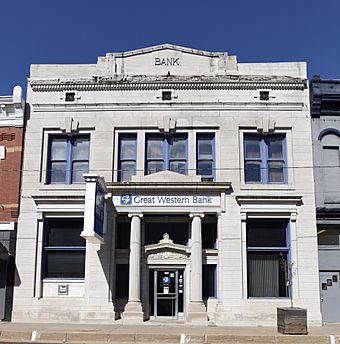Bedford Commercial Historic District facts for kids
Quick facts for kids |
|
|
Bedford Commercial Historic District
|
|

Bedford National Bank (1908)
|
|
| Location | 200-500 blocks of Main St., the 500 and 600 blocks of Court, and the 500 block of Central, Bedford, Iowa |
|---|---|
| Area | 11 acres (4.5 ha) |
| MPS | Iowa's Main Street Commercial Architecture MPS |
| NRHP reference No. | 02001032 |
| Added to NRHP | September 12, 2002 |
The Bedford Commercial Historic District is a special area in Bedford, Iowa. It includes many old and important buildings in the town's main business area. This district was added to the National Register of Historic Places in 2002. This means it is recognized as a place important to American history.
The historic district has 50 properties that were looked at in a survey from 1989. Out of these, 47 buildings and four structures are considered "contributing." This means they help show the area's history and importance. Only three buildings are "non-contributing," meaning they don't fit the historic period. An important building in the district is the Bedford House/Garland Hotel, built in 1857 and updated in 1877.
How Bedford's Downtown Grew
The downtown area of Bedford first started to grow where Court and Main Streets met. This spot was close to the Taylor County Courthouse. The courthouse was an important building, so businesses wanted to be nearby.
The Railroad's Impact
Later, when the railroad came to Bedford, things changed. The town's main street, Main Street, started to develop more. It gently slopes down towards the east, which is where the railroad tracks were built. The railroad brought new ways for goods and people to travel. This helped the businesses along Main Street grow even more.
Why This District Is Special
The Bedford Commercial Historic District is known for its well-preserved buildings. Most of these buildings are made of brick and were built in the late 1800s. It stands out compared to other towns of similar age and size in Iowa. This district is a great example of how commercial areas looked and functioned a long time ago. It helps us understand the history of towns in Iowa.



